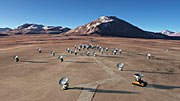ALMA and Interferometry
Why do we refer to ALMA as a single telescope, when there are many separate dishes dotting the Chajnantor plateau? These dishes make up the array of antennas mentioned in the name Atacama Large Millimeter/submillimeter Array. The advanced design of ALMA allows the dishes to work together as a single telescope, more powerful than any single dish could be. Indeed, without this technological feat, ALMA’s ambitious scientific goals would be unattainable. This is due to a fundamental limit placed on any telescope with a single main dish or mirror, which governs the achievable sharpness of its vision. It is a limit that particularly affects observations at relatively long wavelengths, such as the millimetre and submillimetre wavelengths at which ALMA operates.
The resolution (or degree of detail in the image) of a single telescope depends both on the wavelength it operates at and on the diameter of the main dish or mirror. The longer the wavelength, the worse the resolution, and the larger the diameter, the better the resolution. Consequently, a long-wavelength radio telescope has worse resolution than an optical- or infrared-wavelength telescope of the same size.
ESO’s optical and infrared Very Large Telescope on Cerro Paranal has Unit Telescopes with mirror diameters of 8.2 metres. At infrared wavelengths of about 2 micrometres, it has a maximum resolution — using adaptive optics — of about 50 milliarcseconds (a little over ten millionths of a degree). The ALMA dishes have a diameter that is, at 12 metres, about 50% greater than the VLT mirrors. However, ALMA observes at wavelengths that are in the millimetre range, up to a thousand times longer than infrared light. This far outweighs the slight size advantage that the ALMA dishes have over the VLT mirrors and so a single ALMA antenna would have a resolution, at millimetre wavelengths, of about 20 arcseconds.
In fact, to have a comparable resolution to the VLT, a single ALMA dish would therefore need a reflecting surface with a diameter of several kilometres — clearly not a feasible construction proposition. This is why ALMA consists of an array of many individual antennas spread out over a very large area, working together in what is known as an interferometer.
The resolution of an interferometer depends not on the diameter of individual dishes, but on the maximum separation between the antennas. Moving the antennas further apart increases the resolution. The signals from the antennas are brought together and processed by a specialised supercomputer — the ALMA correlator — to mimic the effect of a single telescope. In other words, an interferometer acts like a single telescope that is as large as the whole array.
Increasing the maximum distance between the antennas increases the resolving power of the interferometer, allowing it to detect smaller details. The ability to link antennas over baselines of many kilometres is crucial to obtaining extremely good resolution and a high degree of detail in the images.
ALMA’s main array has fifty 12-metre antennas, arranged in configurations spread over distances from 150 metres to 16 km. The array thus simulates a giant, single telescope much larger than any that could actually be built. In fact, ALMA has a maximum resolution which is even better than that achieved, at visible wavelengths, by the Hubble Space Telescope.

Four additional 12-metre antennas and twelve 7-metre antennas form the Atacama Compact Array. The smaller 7-metre antennas can be clustered more closely together without bumping into each other, and, because of the way interferometers behave, this compact arrangement allows them to see the broader structure or “big picture” of the astronomical objects that are observed. In addition, the four 12-metre antennas of the Atacama Compact Array are used separately to measure the absolute brightness of the objects observed — a quantity that cannot be measured with an interferometer.
The different configurations of the telescope allow astronomers to probe both the broad structure of an astronomical source and its very finest details. However, to switch between compact and wide configurations of the array, the antennas must be physically moved. This is done with two custom-built transporters, designed to lift the antennas, which each weigh over 100 tonnes, move them kilometres across the desert, and position them on concrete docking pads with millimetre precision.
Thanks to the technique of interferometry, ALMA’s many antennas work together as a unified science machine, letting astronomers make observations that would be impossible with a single dish. This is why we can think of ALMA as not just many antennas, but as one, revolutionary telescope.
Further reading:
For more technical details of ALMA as an interferometer, see the article “How Will ALMA Make Images?” from issue 5 of the ALMA Newsletter.

